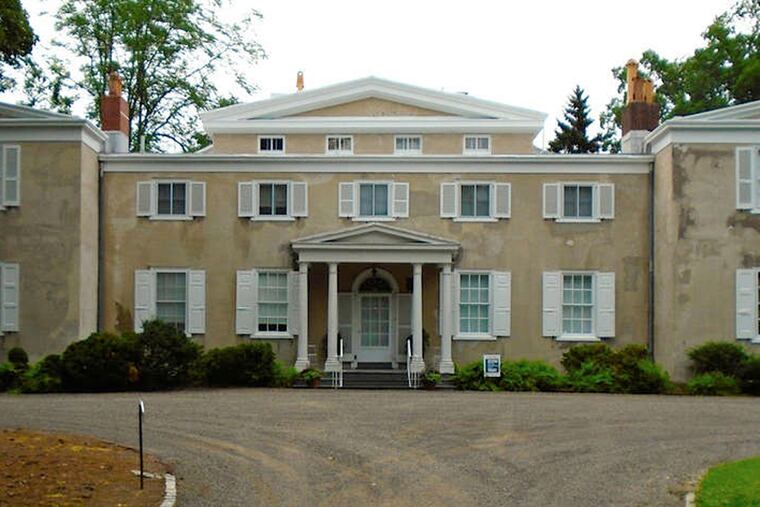Delaware River mansion conjures history and serenity
There were speed traps set down along East Roosevelt Boulevard on my way to Andalusia. The air was steam, the heat was yellow gravy, and at every little stretch of road, like commas marking a long sentence, police cruisers were doing business with the newly penalized.

There were speed traps set down along East Roosevelt Boulevard on my way to Andalusia. The air was steam, the heat was yellow gravy, and at every little stretch of road, like commas marking a long sentence, police cruisers were doing business with the newly penalized.
I'm a good driver, but I'm rarely a happy one. I'll take a quiet country road to any speed-trapped high- or byway. By the time I finally turned left on State Road and paralleled the Delaware River, I felt my heart rate slowing. Here were trees and here was calm. Here was space for pondering.
Down a pebbled road I saw the famed estate - "the most beautiful and valuable place on the Delaware River, or, in fact, in the vicinity of Philadelphia," it was said of Andalusia in November 1865. I rolled down my window and heard the crunching of my tires. A gardener waved. I parked on grass. I was by myself, and now wandering.
I could hear the sound of shears in a garden of wisteria, the quick sprint of wild turkeys, the rustle of squirrels in trees. I could walk in any direction upon this pastoral and see - that mansion, this cottage, that garden, that restored grapery, this grotto, that river walk, this legacy of the historic Craig and Biddle families.
It was Jane Craig who, at the age of 18, in 1811, married Nicholas Biddle. She was shy and disinclined to parade her wealth; she loved her childhood home of Andalusia. He was, and would continue to be, something - graduating at 15 from Princeton as the valedictorian, attending Napoleon Bonaparte's coronation, befriending Daniel Webster, auditing the Louisiana Purchase, carrying on as a financier even as he edited a fine-arts journal (and the Lewis and Clark report), undertaking the creation of Girard College (on behalf of his deceased friend, Stephen Girard), and ultimately becoming the last president of the Second Bank of the United States.
As a public man, Biddle lived glorious days and panicked ones. He was beloved but also (in the end) held (fairly or not) partly responsible for a broken economy. But at Andalusia, where the slight hill rises up from the rocky riverbank, where the tall ships still sometimes come, where the turtles float, where the clangor of Philadelphia was 13 miles south, he had his share of peace.
Having bought the place from the John Craig estate, Biddle raised his family there, built (trial and error) that grapery there, dreamed of mulberry trees. He brought his friends to the house, hung their portraits in his library, pursued the sweet-milked Guernsey cow until it became established on both his property and in other herds.
Benjamin Latrobe and Thomas U. Walter had both influenced the architecture of Biddle's home. He left their imprints as they were. Left history in place, and history is indeed what you find as you walk the grounds, as you travel in past the door and in through the rooms that are bright with yellow velvet, marble busts, glassed-in bookcases.
I was to meet students that day at Andalusia. The young people of the Fairmount Water Works Project FLOW as well as a dozen youth (and their adult leaders) from the San Angelo Independent School District of Texas - kids who call themselves the Aqua Squad.
I had been asked to draw these young people from opposite parts of our country together through interviews and conversations. To set them off on minor explorations in pursuit of Andalusian wonder. I was to sit with them on the checkerboard veranda of the mansion beside the ample Doric columns, read to them from the 1886 diary pages of a young Kitty Biddle, and send them out into that garden to explore the inner lives of colors.
But right then I was alone. The bus had not arrived. Yet. Not Project FLOW, not Aqua Squad. Not the dark-haired girl who would write her story from the perspective of a shadow. Not the boy who would confide about his Mexican grandparents, not the tall kid with the "Let's Get Weird" T-shirt who would speak on behalf of the color red, not 14-year-old Sashoya Dougan, who would sit on that veranda contemplating the river and counting the years between now and the time she will say her wedding vows just beyond those Doric columns.
None of that. Yet. It was still just me and the gravy of heat and the crunch of the pebbles on the path beneath my flip-flops and the quill-sized feathers that the scrambling turkeys had shirked off. Me thinking about the early goodness of the Biddle days, about the big risks of any ambitious life, about the tides that always turn and, if we're lucky, if we live and hope long enough, will turn back again.
I was thinking about how it is the land itself that quiets us, the rivers and their flow, the overlay of big tree boughs, the breeze that finally blows. It's the land we return to in a blaring speed-trap world, it's the pastoral up from the city. It's also the middle-school kids who roll in on that bus and run quick up that path. Those kids, declaring themselves ready for magic.
Beth Kephart is the author of 19 books, including "Love: A Philadelphia Affair," a collection of Inquirer essays, which will be released Sept. 7.
Kephart blogs daily at www.beth-kephart.blogspot.com.